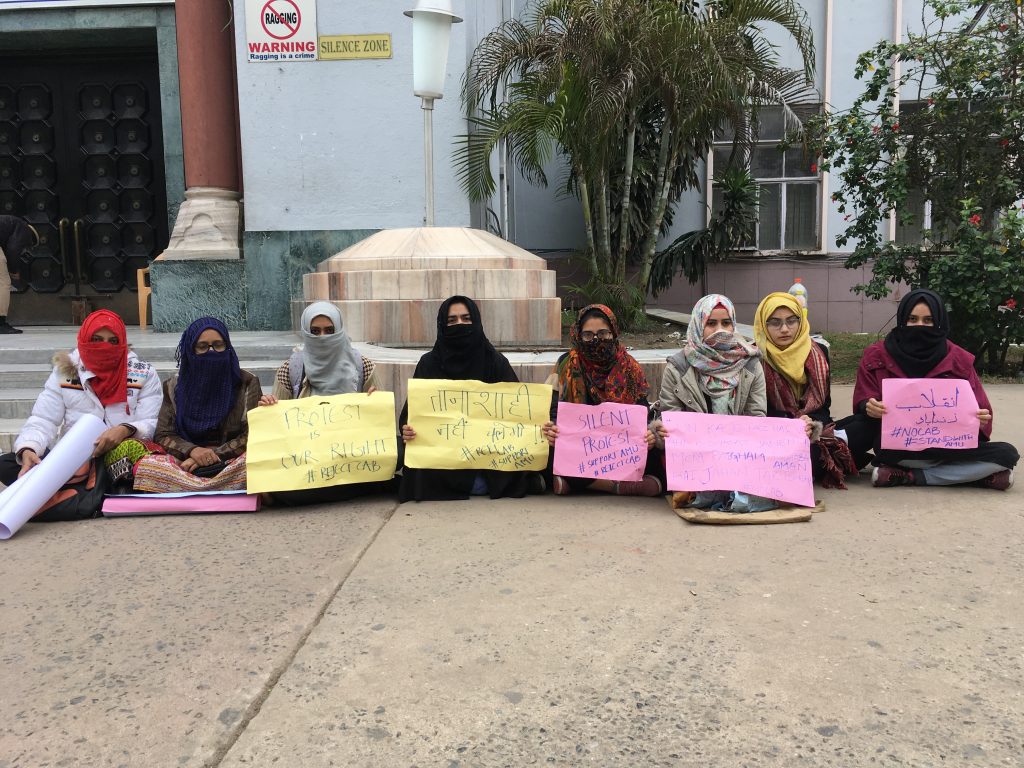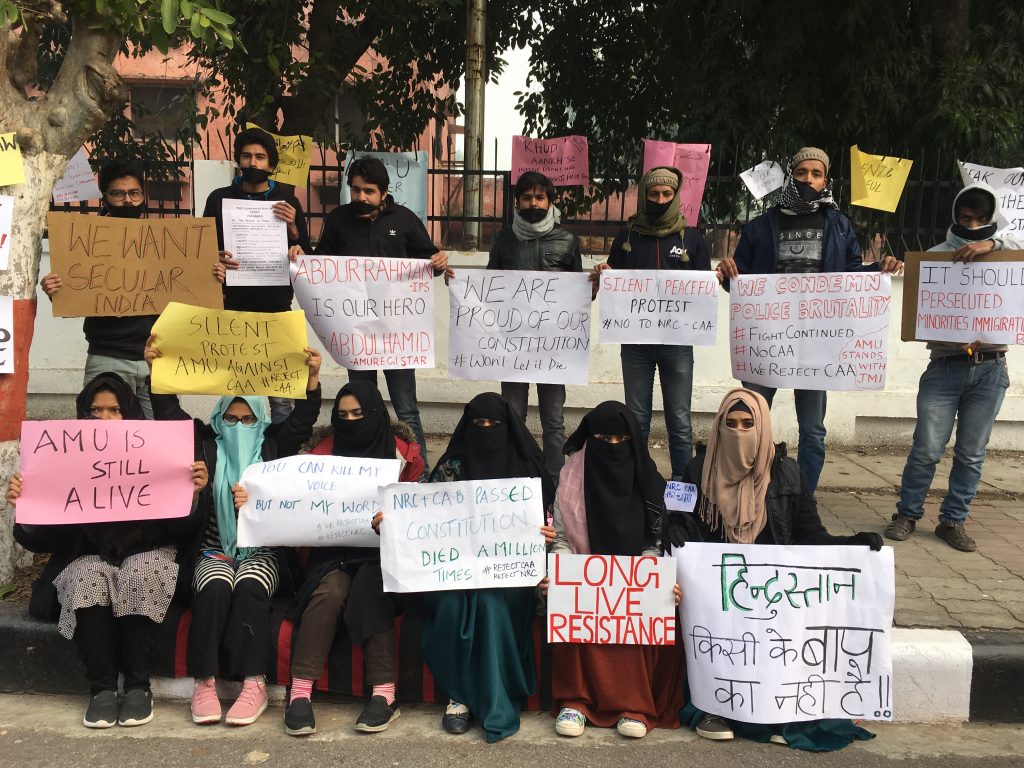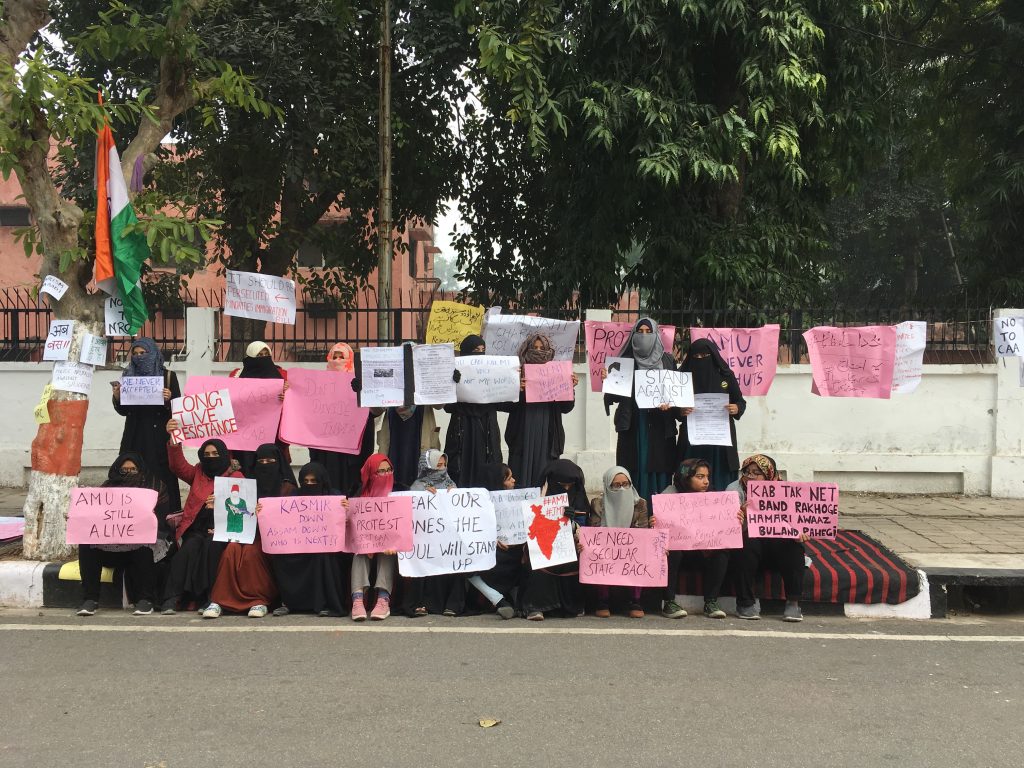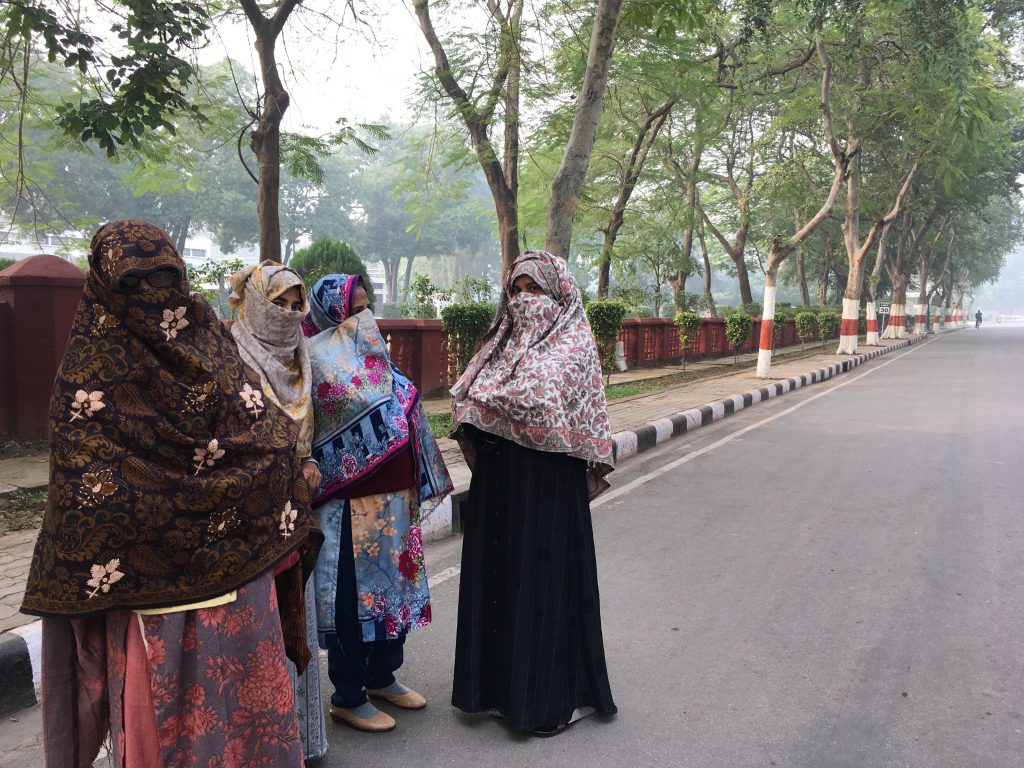Text and photos by Meher Ali, TwoCircles.net
Aligarh: On the night of 15 December, Ayesha (20) and Tuba (21), two students of AMU sat in their homes listening to the sound of tear gas bombs coming from the university. Then students started calling them saying that they were being beaten up by the police. “Hamein itna hopeless mehsoos hua—We felt so hopeless,” says Tuba. They discussed among themselves and, after the violence that had marred Sunday night protests, they decided that a peaceful, silent protest would be the better strategy.

This is how I met them, sitting outside, below the steps of the Maulana Azad Library holding placards that read: “Silent protest #SUPPORTAMU #REJECTCAB,” “Protest is our right #REJECT CAB”, and “Tanashahi nahi chalegi—We do not accept dictatorship”.
It has been a week since their protest and since then, they have come to articulate clear goals for their dharna: the first aim is to sustain it till the hostelers return, the second is to register their protest, along with the rest of the country, against the Citizenship Amendment Act (2019) or CAA, and the third is to get Vice-Chancellor Tariq Mansoor to address the police brutality that AMU students were subjects to on Sunday night.

Since then, their numbers have also grown: from four women students to about 15, including male students who joined them starting Wednesday. The boys said they were not giving sound bytes to video journalists and only spoke to this reporter because she is a print journalist. They had a black cloth tied to their mouths, highlighting the silent aspect of their protest, and when asked about their reason for joining, one of them said: “Hamari sisters ne hamein himmat di—our sisters gave us courage.”

On the third day of their protest, about 20-25 women from the Civil Lines area and other neighbourhoods tried to join their protest. Tuba says that they told them: “Students ka rehna zyada zaroori hai—it is more important for students to be present,” adding that if they wanted to support the AMU protest, they could stand outside the Bab-e-Syed gate, where the protest had shifted from the library a day later.
Tuba and other students were worried that if outsiders joined them, the university administration would shut them down saying “yeh[outsiders] students ko behkah rahen hai—they are misguiding students,” and the situation could turn violent. The Aligarh women, who themselves had been on a dharna protesting against CAA at Khwajah ki kothi, less than a kilometre away, agreed and returned to their original spot.
Yesterday, Tuba says that some among the protestors started questioning the silent nature of the protest and instead wanted to chant slogans to get the university authorities’ attention. But Tuba, Ayesha and others stopped them.
They explained to them that 15-20 students chanting slogans would only result in their protest being shut down. They didn’t have the numbers. The young women pointed out that a silent protest had its own merits. Tuba said that she told the students that if they were silent, the public and the media would come to them of their own accord and ask them the reason for their protest.

Their decision to remain peaceful and silent has in fact paid out. While I was first of three reporters that they spoke to at the start of their protest, by Friday, they had given sound bites to a total of eight media persons.
‘Those children are ours too’
It is not just the protesting students but some university staff, teachers and residents who have also helped ensure that this protest remains silent and peaceful.
When a group of 12-15 women, some of them alumna, tried to join the AMU women’s protest this Friday, one of the university guards stopped them at the barricades before Bab-e-Syed gate. There was a brief back and forth, and then the women agreed to stand on the road opposite the gate and protest.
They tried to enter a second time, and after repeating that they had instructions to not let in anyone who was not a student, one of the guards said: “Hum bachiyon ka protest kharab nahi hone dena chahte—we don’t want the girl students’ protest to be disrupted.” The residents then resumed their former place of protest and dispersed within an hour.
When Dr. Musavvir Ali, Acting President of Aligarh Muslim University Teachers’ Association (AMUTA), went to meet the students with his colleagues, a man who had his face covered joined the students to hear him speak. Dr. Ali recognized this man to be a non-student and asked him to leave the protest which he did.
And then there was a group of women who, when asked by this reporter why they had come to join students, said: “Woh bachche bhi hamare hi hain—those children are ours too.” When they were told by the university staff that they would not be able to so, they promptly turned back and made their way to Jamalpur to see if they could join a sit-in of other women protestors.
But the students’ dharna continues to face sporadic threats.
On Thursday 19 December, a group of university proctors asked the students to shift their protest from Bab-e-Syed gate to Duck Pond, some 900 metres from the main gate, saying that that was the designated location of the protest. The students allege that one of them also threatened them by saying: “Naam yaad rakho iska—remember her name.” And: “Apni had mein reh tu—stay within your limits.”
The students then called Dr. Ali who, in turn, called Assistant Proctor Ashraf Mateen, who was with the proctorial team. They left after advising students to carry their ID cards and to not let any non-students join their protest. Professor Mateen told this reporter yesterday that the students will not be removed from their place of protest so long as their protest remains peaceful.
Another time, a former student union member asked them to display a placard that demanded the withdrawal of FIRs filed against some students but the students refused as they want their protest to be one comprised of the general student body, without any political affiliations.
When I ask Tuba if she feels the pressure of keeping the protest peaceful, she says she does. “Pata nahi ye 10-12 din kaise katenge—I don’t know how we will get through these 10-12 days [until the university opens].”
Her family too is worried that the university administration make take action against her. At the same time, seeing her go sit in a dharna day-after-day, they too have started educating themselves and other people about the provisions of the CAA.
Tuba says this is crucial in the context of the government making light of the implications of this Act. She says it is time for people to step out and stand against it: “Yahi waqt hai…karna padega…Iske alawa aur time nahi aayega—This is the time…we have to act…there is never going to be another time.”
*
Meher Ali is an independent journalist based in Aligarh. She is the 2016 recipient of the RedInk Award in Human Rights reporting awarded by the Mumbai Press Club. Her blog (meheraligarh.blogspot.com) captures the lives of people who live and work in Aligarh. Twitter: @aashi310. Website: meherali.contently.com.


